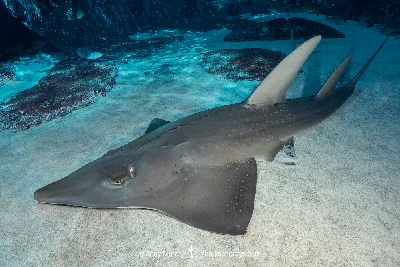Whitespotted Wedgefish
Rhynchobatus djiddensis
The Whitespotted Wedgefish (Rhynchobatus djiddensis) is a large species characterized by its distinctively pointed, somewhat bottle-shaped snout, with a length measuring 3.6-4.7 times the orbit length. It features spiracles with two short, equally-sized skin folds. The anterior margins of its disc are nearly straight or slightly undulating, while the pectoral apices are bluntly angular, and posterior margins remain straight. Notably, the species has prominent thorns in a continuous row along the midline, as well as around the eyes and above the spiracles. There are two thorn rows on each shoulder, with the upper row divided into two sections and the lower row being very short. Occasionally, there is a small cluster of thorns on the cheek.
In adults, the dorsal fins are tall and falcate, with the first dorsal fin being slightly larger than the second and originating anterior to the insertion of the pelvic fins. The caudal fin is large, featuring a deeply concave posterior margin and a well-defined lower lobe. A lateral keel extends along the posterior flank to the base of the caudal fin.
The dorsum of the Whitespotted Wedgefish ranges from dark grey to yellowish-brown, adorned with numerous small white spots or rings distributed along the flanks, extending from the ocelli level to the tail. These spots form 4-5 rows along the flanks, being more prominent in juveniles. The flanks typically exhibit large, dark ocelli equivalent in size to the spiracles, often found above the pectoral fin. A dusky or dark mask frequently appears across the eyes. These markings may vary in prominence or be absent altogether. The ventral side is white, often displaying small dark spots near the tip of the snout.
The species can reach a maximum length of 310 cm, with a size at birth of approximately 60 cm. It inhabits tropical and subtropical marine environments, predominantly demersal on soft substrates, occasionally adjacent to coral reefs, ranging from close inshore areas to depths of 70 meters.
Geographically, the Whitespotted Wedgefish is found throughout the 🌊 Indian Ocean, from 🇿🇦 South Africa to 🇴🇲 Oman and the Arabian Gulf. The occurrence of this species further east remains unverified due to challenges in distinguishing closely related wedgefish species.
Reproduction is aplacental lecithotrophic viviparous, with an average litter size of 4 offspring. The diet predominantly consists of demersal fishes, crabs, and bivalves.
This species exhibits migratory behavior. Tagged individuals in the region of KwaZulu-Natal (🇿🇦 South Africa), 🇿🇦 South Africa, have shown seasonal absence in winter, likely due to northward migration.
The Whitespotted Wedgefish has become rare along much of the east coast of Africa due to overfishing, although it remains relatively common in 🇿🇦 South Africa. Sightings often occur at dive sites in Sodwana Bay, and the species is frequently caught by beach fishermen in Zululand and KwaZulu-Natal (🇿🇦 South Africa), suggesting that dive sites along this coastline may be productive, particularly in the summer months. Conducting studies on the Whitespotted Wedgefish in these regions can provide valuable insights into its current population status and migratory patterns.
Comments
Please, sign in to leave comment
No Comments yet
Last Update: May 28, 2025

